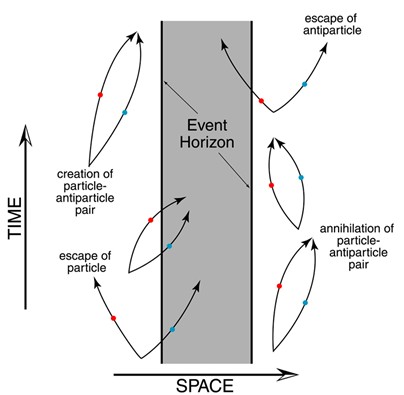Lets take it one step at a time.
All bodies radiate with black body radiation, which means that in a vacuum they would cool down to the ambient temperature of the Cosmic Microwave Background radiation , which is a black body radiation characterized by the temperature of 2.7260±0.0013 K .
Now a black hole is a construct specific to general relativity, and classically it should not radiate at all, because everything within the event horizon cannot leave the black hole classically.
In 1975 Hawking published a shocking result: if one takes quantum theory into account, it seems that black holes are not quite black! Instead, they should glow slightly with "Hawking radiation", consisting of photons, neutrinos, and to a lesser extent all sorts of massive particles. This has never been observed, since the only black holes we have evidence for are those with lots of hot gas falling into them, whose radiation would completely swamp this tiny effect. Indeed, if the mass of a black hole is M solar masses, Hawking predicted it should glow like a blackbody of temperature
6 × 10^-8/M kelvins,
This is a very small number and the energy of the individual photons is so low that no particle of the standard model could materialize out of this energy unless it is a micro-black hole .
The argument for the radiation comes from an effective field theory, as gravity has not been consistently quantized , so it is a heuristic argument to talk about virtual pairs, one falling into the black hole and the other leaving, the energy supplied by the gravitational field of the black hole.
Here is a heuristic image of the feynman diagrams , heuristic because it misses the gravitational vertex that will supply the energy for the reality of the escaping particle.

An analogous image could be devised for escaping photons, from a two photon diagram .
My problem with this model is that any space-time curvature should also allow this to happen; even around us on earth.
To speak of Hawking radiation we have to go quantum. Feynman diagrams need vertices with precise rules of calculating the probabilities. In the sense you are asking it, any loss of the invariant mass of an object in space changes the curvature. Since there is no event horizon for small objects the radiation that will involve exchanges of gravitons will join the black body radiation from the electromagnetic interactions and it will not be separable. Due to the very small value of the gravitational couplings with respect to electromagnetic ones the effect will not be measurable, in my opinion. At least not at the level of knowledge and detectors we have now.
One could think of measuring the black body spectrum of the moon , for example , and Jupiter, and compare the discrepancy from a purely electromagnetic black body , but there will be so many assumptions entering in the model and the difference so small that, imo, no definitive answer can be given.

